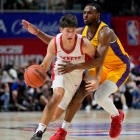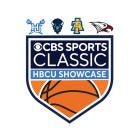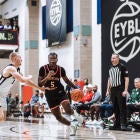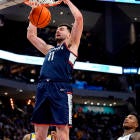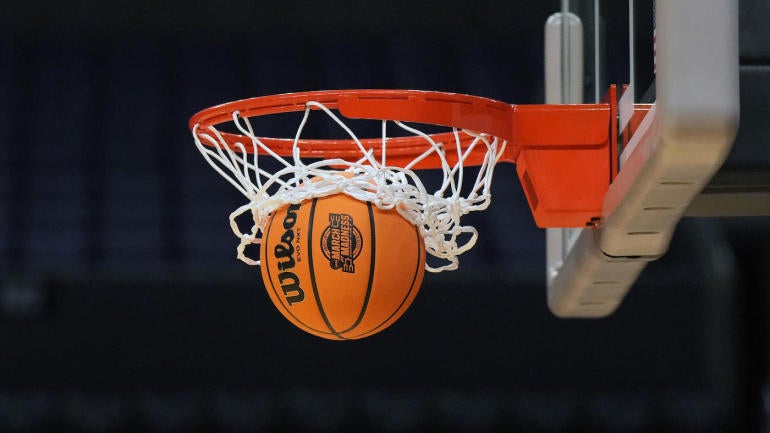
Stodgy old heads dispersed across college athletics — whose power has been reduced and whose perspective on reality is only now finally crystallizing through the one course of action they can't deny: losing their money — may semantically disagree with this next sentence, but I assure you every word of it is fundamental truth.
On Thursday, the NCAA and its richest conferences officially committed to a future that will feature direct payments from schools to college athletes in exchange for their participation in NCAA-sanctioned competition.
The NCAA's archaic amateurism model — which wrongly profited off unpaid labor for nearly the entirety of its existence — is all but finished. Anyone who tries to claim otherwise would merely be repeating the NCAA's time-honored, head-in-the-sand pantomime that led the organization to this point of humbling inevitability.
The NCAA and its five co-defendants (ACC, Big Ten, Big 12, SEC and the soon-disbanding Pac-12) in the House v. NCAA case all voted to avoid going to trial and are moving forward with a settlement and the signing of term sheets that will require two gargantuan commitments: nearly $2.8 billion worth of back pay over the next decade to more than 15,000 former college athletes who did not receive name, image and likeness benefits between 2016-21; plus a signed pledge to invest millions of dollars annually at the power-conference level for the next 10 years to continue to pay college athletes, no matter what sport they play or how accomplished they are. The star quarterback will earn a stipend just as the backup lacrosse goalie and second-string soccer striker will.
It's a foundational philosophical change that could sustain from now through the everlasting continuation of American college sports. In the past five years, the NCAA has found itself routinely pulled into evolutionary and revolutionary change. This is not only the latest iteration, it's the most symbolically and financially significant alteration in the organization's history.
It must be noted: This week's votes to settle were necessary steps before many more legal and bureaucratic measures are taken in the months ahead. Most critically, the California-based judge in this case, Claudia Wilken, has to approve the terms of the deal in order for it to take effect beginning in 2025. There are also settlement papers to be delivered in two other cases (Hubbard v. NCAA and Carter v. NCAA). And NIL fundraising isn't going away; that's a separate topic altogether. A lot still has to be hashed out.
As Michael McCann keenly observed for Sportico, "Once schools see the actual price tag they face, expect push back. Keep in mind, many schools are already worrying about finances given that the college-age population in the U.S. is projected to drop from 2025 to 2037 due to declining birth rates. Some schools are already budgeting for lower tuition, housing, meal plan and student fee revenues. A world where their costs for athletics will climb couldn't come at a worse time."
In many ways, the problems are just beginning. But this house needs to burn down in order to build a better one for the future.
How we got here came with 11th-hour controversy and a heavy dose of irony. It came by way of coercion — forced, of course, by an antitrust lawsuit — and only materializing due to the threat of a much more ruinous result (purportedly many billions of dollars), had said lawsuit gone to trial instead of being settled for less than $3 billion.
Here's the irony: We all realize that the riches of college football — money already attained, but also the fortunes promised in billions of dollars in multimedia revenue expected over the next near-decade — rolled college sports to this point. But college football isn't solving anything. The only reason we have a settlement is because of college basketball. The men's NCAA Tournament made this possible. That's been lost in a lot of the discussion and reaction to this historic news.
College football is what affects change, stokes chaos and dictates conference realignment. In many ways, it's done more harm than good. But it's college basketball and the money generated via March Madness for decades that is saving the day.
"The men's basketball tournament is bailing everybody out," one high-ranking industry source told CBS Sports. "The NCAA lost out on the authority to manage college football money. Men's basketball is helping save, at least maybe has saved, all the other sports."
The NCAA office is going to pay approximately 40% of the settlement bill. And where did that money come from? Men's NCAA Tournament revenue accrued over the years, in addition to cost savings and insurance plans. The remaining near-60% of the damages will be paid off by every conference. Of that ⅗ portion (somewhere between $1.6 and $1.7 billion), 60% of it will be paid out by conferences outside the Power Five. That equates to somewhere north of $975 million over a 10-year period for multi-bid and mid-major leagues to foot the bill.
And what's paying for that? Not College Football Playoff revenue. This is largely being covered by past and future money made off the March Madness event. Without it, the NCAA has nothing.
Yet (here's the cruel part) the small schools, mid-major conferences and multi-bid leagues are still going to get financially hammered, especially in relation to how the bigger conferences will be better equipped to handle the financial blow later this decade thanks to the billions to made from high-profile college football into the 2030s. The NCAA is only agreeing to settle because it has future NCAA Tournament media rights payments that will be withheld by the NCAA to member institutions — basically like garnished wages for everyone from Alabama and Ohio State to the low rungs of Division I.
Things just got a lot more difficult for every league not named the ACC, Big Ten, Big 12 and SEC. (Even a lot of schools the ACC and Big 12 have things to work through; their media deals pale in comparison to the Big Ten and SEC.)
But for the likes of the basketball-focused conferences (Big East, Atlantic 10, WCC), let alone the one-bid leagues that will now be paying around $3 million annually as a result of this settlement? The cost of doing business has never been tougher.
"The Big East and all those other leagues, they should be pissed," an industry source said. "The Power Four just developed a CFP model that keeps everyone out and they get to keep the cash. We're thankful [basketball] can bail everyone out, but holy crap, that's not talked about enough. All they're doing is withholding future earnings, and the only way they got it is men's basketball."
The richest high-major conferences are footing 40% of the payments, yet the majority of the back pay (speculated to be near, if not north of 90%, according to sources) will be going to football and men's basketball players. All this has led to genuine anger from just about every conference outside the Power Four structure. Many commissioners are refraining from speaking on the record, but their opposition has been plainly vocalized behind the scenes. Their leagues don't have the earning capacity of the ACC, Big Ten, Big 12 and SEC due to inferior or non-existent revenue deals with the CFP. Everyone else will be stuck either trying to invent massive new revenue streams or be forced to cut costs.
The problem could have been alleviated if the power conferences even agreed to meet halfway and go 50/50 with everyone else. That's not happening. It's by way of a formula based upon how many scholarships schools had and how much money they made from playing in the men's NCAA Tournament.
"We don't have a say in it. We're stuck. They can just do it," Big Sky commissioner Tom Wistricill told CBS Sports. "It's devastation without representation."
Attorneys representing the plaintiffs in the case and the plaintiffs themselves (ACC, Big Ten, etc.) didn't apprise their commissioner contemporaries of the anchor they were tethering them to until earlier this month.
"It's analogous to being in a boat in the open ocean on a fairly clear day, and then all of the sudden just getting hit by one of the worst storms possible. That's what it felt like," WCC commissioner Stu Jackson told CBS Sports. "After being informed, it was clear that both of those items had been discussed for a period of time, but as an FCS conference, we only found out about the settlement a little over a couple weeks ago. In finding out, it gave little time to assess the impact in our direction. That's a bit alarming."
It's a two-part agreement: payment for lost earnings from 2016-2021 (every league has to pay up) and committing to future payments (a mandatory opt-in for the Power Four). Most leagues outside the biggest ones can't afford future payments and won't be opting in.
The Big East? I reached out to commissioner Val Ackerman on Thursday, but she wasn't up for talking on the record. It's estimated schools in her conference — none of which, except for UConn, sponsor FBS football — could have to opt in to more than $750,000 annually in player payments in order to remain competitive in recruiting at the high-major level. Overcoming this won't be impossible — NIL recruiting and the bigger paydays therein are here to stay — but it's going to further separate the haves and the have-nots. The Big East has performed as a top-three league in men's basketball in seven of the past 10 seasons. Maintaining that could become more difficult.
If the Big East is facing a new hike, consider the slope that's steepened for the multi-bid conferences in basketball caught in the in-between: the Atlantic 10, Mountain West, WCC.
"The defendants, honestly speaking, it's not just that they're bigger conferences, but they have the wherewithal for a much wider and several other streams of revenue to be able to cover significant costs as a settlement," A-10 commissioner Bernadette McGlade told CBS Sports. "To appropriate it where the five defendants are paying out 40% and the other conferences are picking up 60% is an imbalance of the financial asset distribution in Division I."
There never has been and never will be competitive equity in college sports, but the gaps are now worsening. Unfortunately, Thursday's news will almost certainly compel further distance from the top to the middle to the bottom in Division I — across all sports. More than 90% of D-I athletic departments don't turn a profit. Revenues will be impacted and expenses are going to grow. Schools might have to cut sports.
"Do we have to reduce our scholarship funding in other sports to stay competitive in basketball? Every school is going to have to look in the mirror and make that decision," McGlade said.
One-bid conferences in basketball could be docked between 300-400K per school each year, which will tally to somewhere around $3 million annually at the league level. This is guaranteed to have downstream effects that further split apart and tier out the power structure in Division I. It's never been harder to be a mid-major basketball program than in 2024, and in the years to come, that reality will only get harsher.
"The Autonomy Five will have a significant increase in expenses as it relates to the go-forward of this settlement, but at the same time, they're in the fortunate position of having protected revenue sources from the CFP as well as the multi-media, mega-media television rights," McGlade said. "From an A-10 perspective, we will make an attempt to set up and opt in as a basketball-centric league, but we'll have to work hard to strategically find those dollars that will be able to match the type of dollars that it will take to opt in to stay competitive and relevant in basketball, which the A-10 unquestionably wants to do."
How much can they do? Schools will be forced to make a number of tough financial decisions, ones that could impact a lot of non-revenue/Olympic sports.
In the WCC, they have very little answers at this point. And this is for a league that is riding high after four key conference additions in the past six months.
"That's the first step, before any decisions can be made, we have to assess where we are and where we're going to be," Jackson said. "My sense is all the conferences are scrambling to understand what that picture looks like."
College sports is pushing into an overdue era of proper player compensation. It's only getting there because basketball bailed out the NCAA, and of course, now the landscape has become more unstable. College basketball's reward for making a settlement possible is to see hundreds of programs scraping by, all because power conferences refused to split up mountain ranges of CFP money. The action might trigger a reaction elsewhere: Further fallout in the months/years could include serious disagreements over the format and finances of the NCAA Tournament when it can be renegotiated.
The greed of the college sports industrial complex led its leaders to this moment. For the people who want to change the NCAA Tournament — who aren't operating in good faith for the betterment of that event — a similar greed still exists. If history is any indication, many of the people in charge will stubbornly choose to not learn from their mistakes.
The NCAA Tournament has long been the best thing about the NCAA. How it's run, what it symbolizes, how it's assembled, televised, all of it. Thank god for the NCAA Tournament. As we now know, not only is it the best thing the NCAA's ever done, it's literally the only thing keeping this whole operation from collapsing in on itself.










